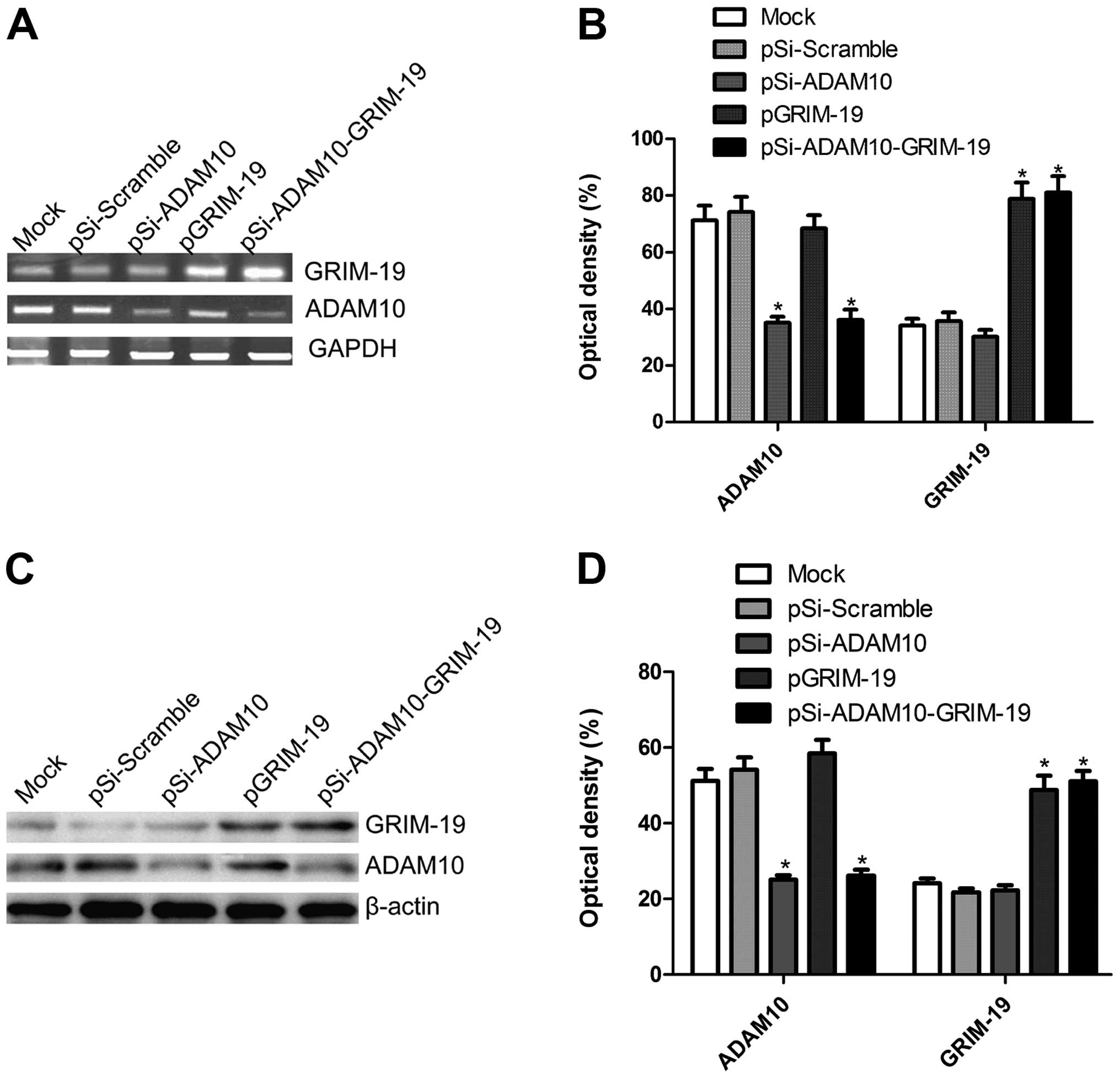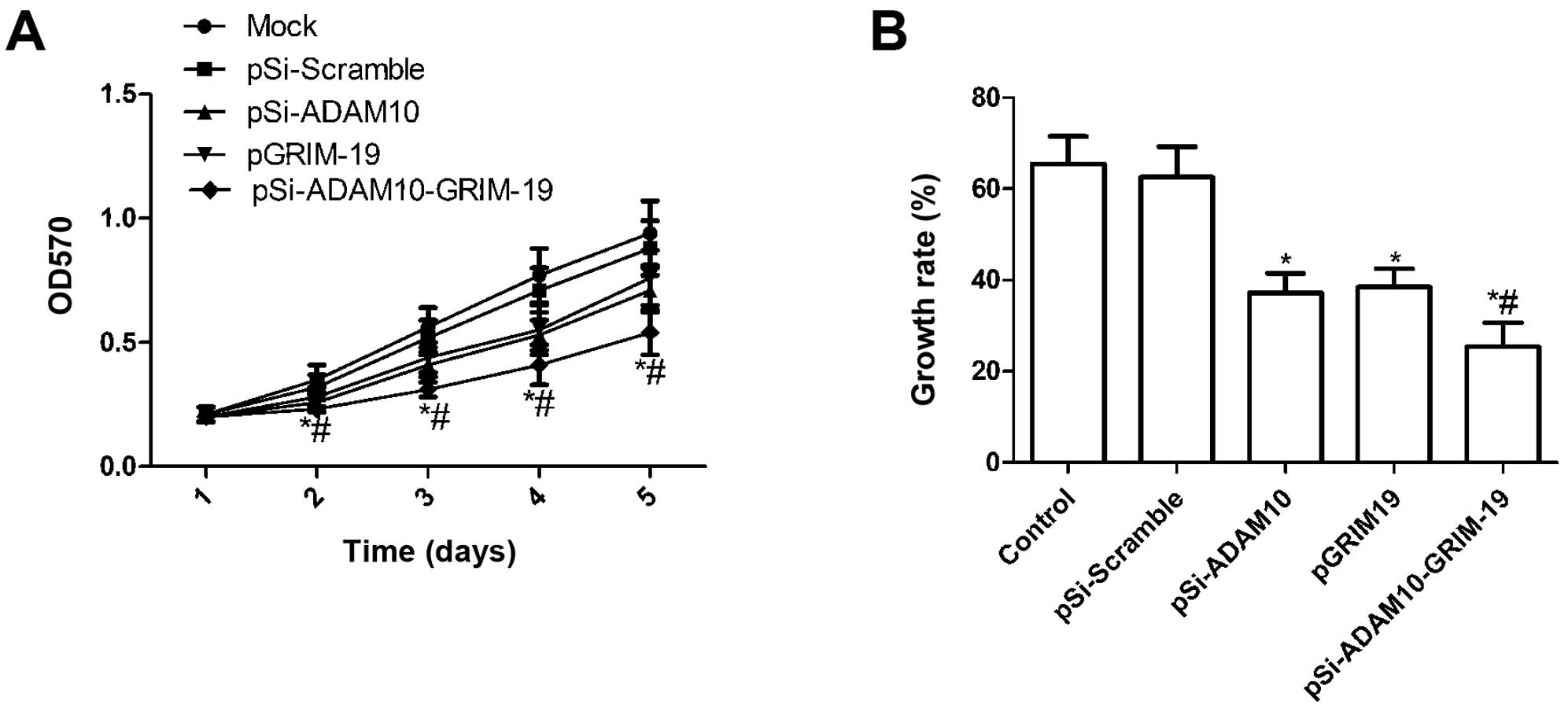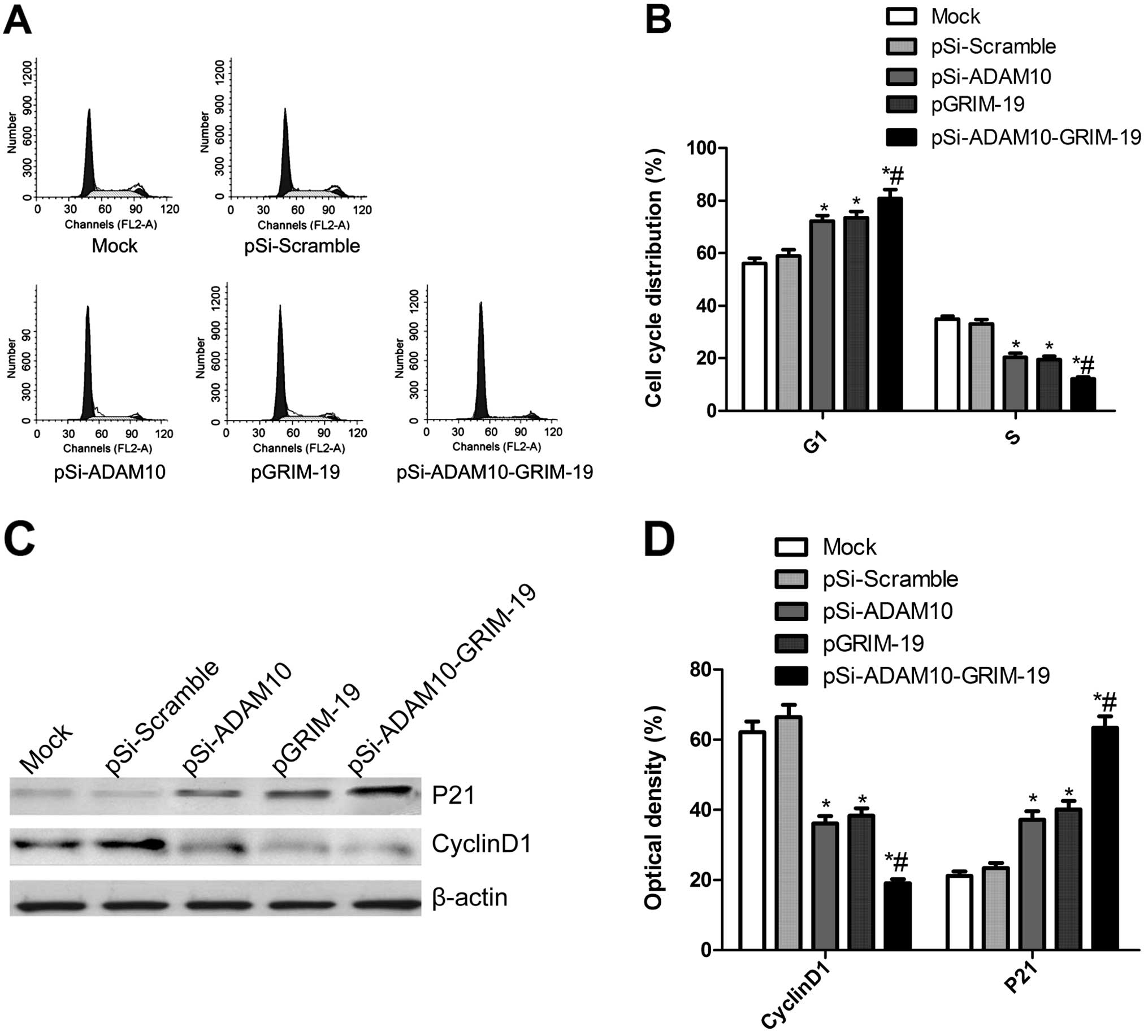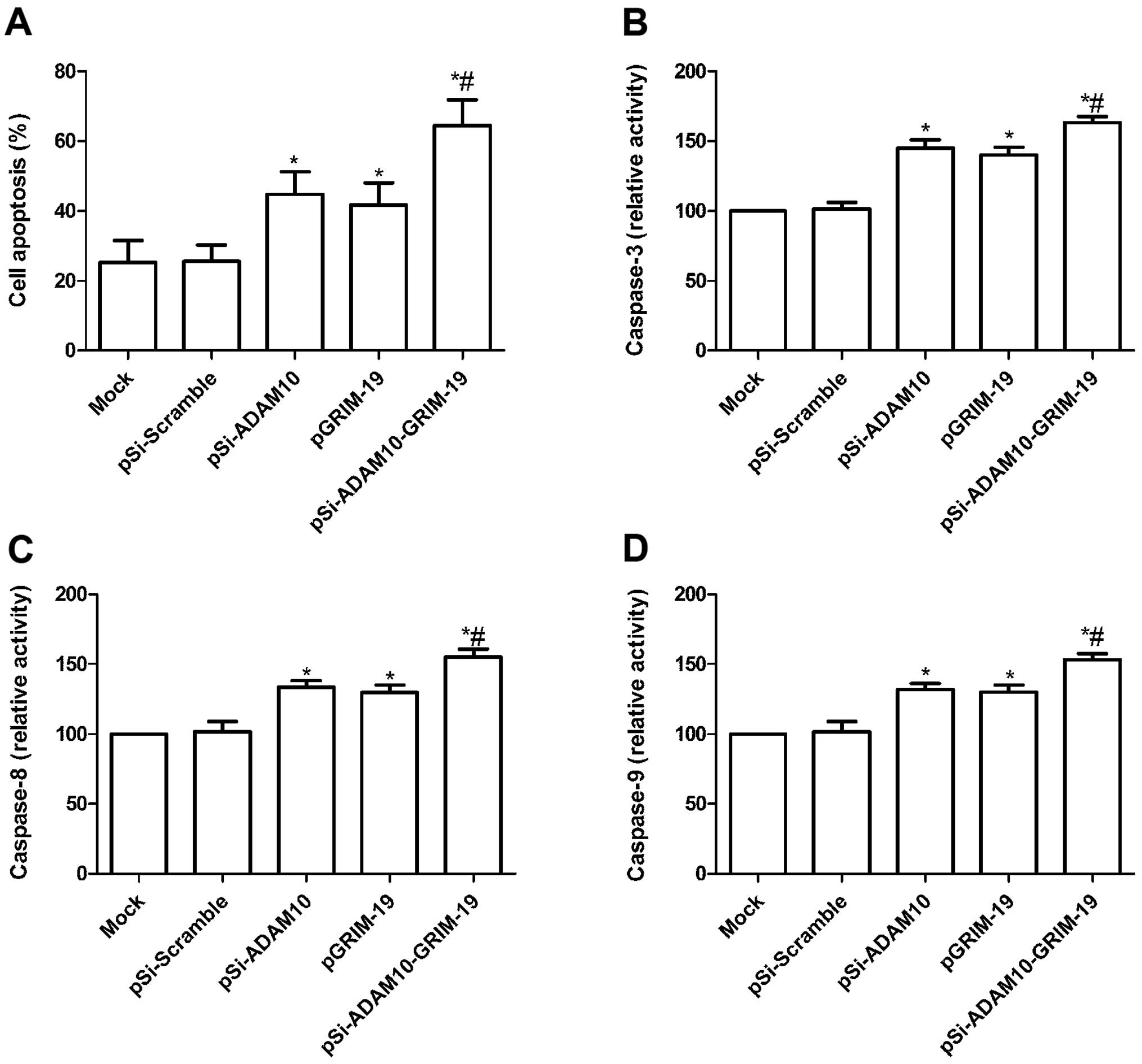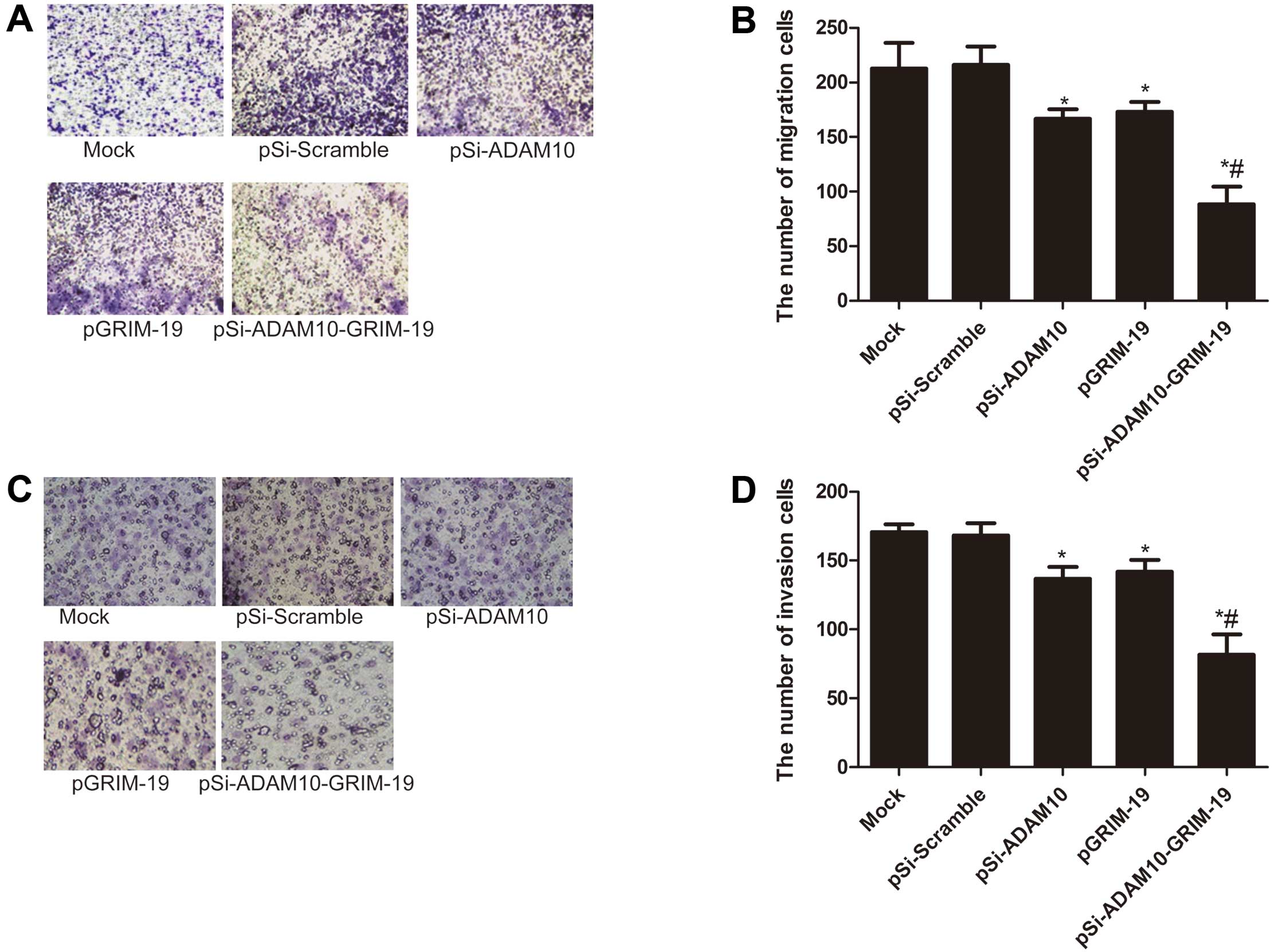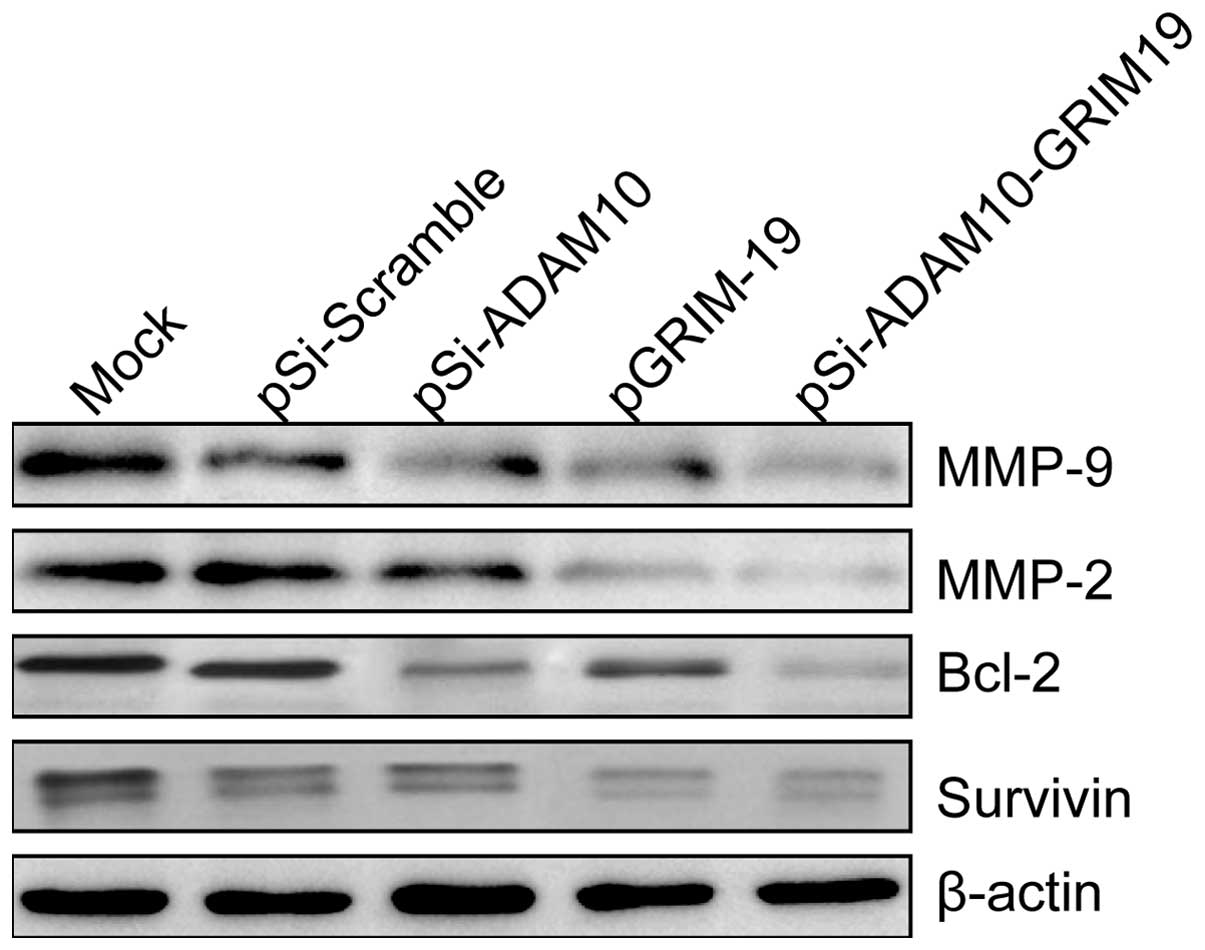Synergistic effects of co-expression plasmid‑based ADAM10-specific siRNA and GRIM-19 on hepatocellular carcinoma in vitro and in vivo
Retraction in: /10.3892/or.2021.8235
- Authors:
- Published online on: September 19, 2014 https://doi.org/10.3892/or.2014.3503
- Pages: 2501-2510
Abstract
Introduction
Hepatocellular carcinoma (HCC) is the third most common and aggressive malignancy in the world, estimated to cause more than half a million deaths annually (1). Although surgery is the best available treatment option for patients with resectable HCCs, high postoperative recurrence remains a major obstacle that influences long-term survival, while most recurrences are due to invasion-related spreading (2). In addition, chemotherapy and radiotherapy offer unsatisfactory response rates. Therefore, it is necessary to explore new strategies to treat HCC. Gene therapy represents an attractive alternative compared with conventional therapies.
A number of studies have identified a disintegrin and metalloproteinase 10 (ADAM10) as a rational target for anticancer therapy (3,4). ADAM10, a member of the ADAM family, has been found to have upregulated expression in a range of tumors including melanoma, pancreatic carcinoma, gastric cancer and oral squamous cell carcinoma (5–8). Consistent with these findings, we recently showed that ADAM10 is overexpressed in HCC tissues and there were significant associations between protein levels of ADAM10 and tumor grade, amount of tumor differentiation, tumor size and the presence of metastasis (9). ADAM10 has been reported to play important roles in cell migration, tumor development and metastasis by proteolytic shedding of cell surface proteins (10,11). Recent reports showed that ADAM10 RNAi-based gene therapy was also a suitable strategy to treat ADAM10-overexpressed cancers, including liver cancer (12).
The gene associated with retinoid-interferon-induced mortality (GRIM) apoptosis-related gene family potentially represents a novel type of tumor suppressors that could act as candidates for use as biological markers and new targets for drug development (13). GRIM-19, a new member of the GRIM family located on human chromosome 19p13.1, encodes for a 16-kDa protein that is present in both nuclear and cytoplasmic compartments (14). It was originally isolated and identified as a growth suppressive gene product involved in the interferon-β (IFNβ)-/all-trans retinoic acid (RA)-induced cell death pathway using a genetic screen (13). GRIM-19 expression has been found to be lost in renal cell cancers, certain prostate and colonic tumors, prostate carcinoma and HCC (15–17). It has also been shown that GRIM-19 suppresses signal transducer and activator of transcription 3 (Stat3) transcriptional activation by inhibiting its functional interaction (18,19). Numerous reports showed that overexpression of GRIM-19 could inhibit cell proliferation, migration and invasion, as well as induce apoptosis in human prostate, breast and gastric cancer, and renal carcinoma cells (15,20,21). Notably, a recent report showed that downregulation of GRIM-19 in the hepatic and HCC cell lines enhanced adhesive and invasive potential of these cells by modulating epithelial mesenchymal transition (EMT) and cell contact inhibition (22). These studies suggested that GRIM-19 may act as a new potential target for treatment of HCCs.
The onset and progression of tumors is a highly complex process and it is very difficult to cure the tumor by using a single therapeutic gene. It has been shown that both ADAM10 and GRIM-19 are ideal targets for cancer gene therapy. However, to date, there is no study adopting a therapeutic strategy targeting the two targets simultaneously to treat tumor. Therefore, the aim of the present study was to test the hypothesis that combinational gene therapy with ADAM10-specific siRNA and GRIM19 gene could result in a better therapeutic outcome. Thus, in the present study, the plasmid carrying GRIM-19 and ADAM10-specific short hairpin RNA (p-Si-ADAM10-GRIM-19) was constructed, identified and transfected into HepG2 cells to examine the effect of co-expression GRIM-19 and ADAM10-specific short hairpin RNA on cell proliferation, cycle, apoptosis, migration and invasion in an HCC cell line (HepG2 cells) in vitro, as well as on tumor growth in xenograft mouse models.
Materials and methods
Plasmid construction
The ADAM10 siRNA sequence (CAGTGTGCATTCAAGTCAA) and the sequence of scrambled control (AATTCTCCGAACGTGTCACGT) were designed and synthesized (Shanghai GeneChem Co., Ltd., China) and cloned into the pSuper siRNA expression vector according to the manufacturer’s instructions. Then, a serial of the eukaryotic expression plasmid was used to construct by pcDNA3.1 (Invitrogen, Carlsbad, CA, USA) as follows: the pcDNA3.1-siRNA-ADAM10 (plasmid pSi-ADAM10) encoding siRNA specific to ADAM10; the pSi-Scramble vector (containing scrambled siRNA sequence) which served as a negative control; pcDNA3.1-GRIM19 containing GRIM19 coding region (plasmid pGRIM-19); and the co-expression plasmid pcDNA3.1-SiRNA-ADAM10-GRIM-19 (plasmid pSi-ADAM10-GRIM19) expressing both siRNA-ADAM10 and GRIM-19 tumor suppressor protein.
Cell culture and transfection
The human HCC cell line HepG2 was purchased from the American Type Culture Collection (ATCC; Manassas, VA, USA). HepG2 cells were cultured in Dulbecco’s modified Eagle’s medium (DMEM) (Sigma-Aldrich, St. Louis, MO, USA) supplemented with 1% penicillin/streptomycin (Gibco-BRL, Grand Island, NY, USA) and 10% heat-inactivated fetal calf serum (FCS; Invitrogen).
HepG2 cells were transfected with various plasmids using the Lipofectamine 2000 reagent (Invitrogen), according to the manufacturer’s instructions.
Semi-quantitative reverse transcription-PCR (RT-PCR)
The mRNA expression levels of ADAM10 and GRIM-19 were examined using semi-quantitative RT-PCR. Cells were collected 48 h after transfection with pSi-ADAM10, pGRIM-19 or pSi-ADAM10-GRIM-19 plasmids. Total RNA was extracted using the TRIzol reagent (Invitrogen). Then, RNA was reverse-transcribed into cDNA using a PrimeScript™ RT reagent kit according to the manufacturer’s instructions (Takara, Dalian, China). According to the cDNA sequences of ADAM10 and GRIM-19 gene in GenBank database, corresponding primers were designed and synthesized by Shanghai Biological Engineering Company (Shanghai, China). For ADAM10, the forward primer was 5′-TCTGAGAAATGTCGGGATGAT-3′ and the reverse primer was 5′-TCTGTAAAGTTGGGCT TGGG-3′. The mixture for PCR included cDNA (4 μl), 25 mM dNTP (1 μl), 10X PCR buffer (5 μl), forward and reverse primer (50 pmol) (2 μl), Taq enzyme (1 U) (2.0 μl) and ddH2O (34 μl). The conditions for PCR were: 94°C for 3 min; 32 cycles of 94°C for 20 sec, 55°C for 20 sec, 72°C for 30 sec and a final 72°C for 5 min. GRIM-19 primers were: forward, 5′-GAGTCACGCACTGTCTGGG-3′ and reverse, 5′-CGGTCGGTTTCTGCCTGTA-3′. The components of mixture for PCR were the same as those above. The conditions for PCR were: 32 cycles of 94°C for 30 sec, 56°C for 30 sec, and 72°C for 1 min and a final 72°C for 5 min. The PCR products were subjected to 1% agarose gel electrophoresis. GAPDH served as an internal reference to normalize the expression of target gene. The experiments were repeated thrice and t-test was employed for analysis.
Western blotting
For western blot analyses, after 48 h transfection, cells were harvested and rinsed once with ice-cold phosphate-buffered saline (PBS) and lysed in ice-cold cell lysis buffer (Walterson, London, UK) containing complete protease inhibitor cocktail (Sigma-Aldrich, Germany). The protein concentration was determined using the BCA protein assay kit (KeyGen Biotech) using a c-globulin standard curve.
Equal amounts of protein (15 μg/lane) from the cell lysates were separated on an 8–12% SDS-polyacrylamide gel (SDS-PAGE) and transferred onto nitrocellulose membranes (Santa Cruz Biotechnology, Inc., Santa Cruz, CA, USA). The membrane was blocked with 5% skim milk in TBS-T (10 mM Tris-HCl, 150 mM NaCl, 0.25% Tween-20, pH 7.5) at room temperature for 2 h followed by appropriate primary antibody in TBS containing 5% skim milk overnight at 4°C. After washing with TBS-T, the membrane was incubated with a secondary antibody in TBS-T buffer for 3 h at room temperature, followed by three washes with TBS-T. The antibody-bound bands were visualized using ECL reagents (ECL, Amersham, GE Healthcare, Velizy-Villacoublay, France), and quantified using the VisionWorksLS software (UVP, LLC Upland, CA, USA). All primary antibodies were used at 1:1,000 and secondary antibodies at 1:5,000. The primary and secondary antibodies used in the western blot analyses were: antibodies against ADAM10, GRIM-19, survivin and Bcl-2 (Cell Signaling Technology, Beverley, MA, USA), p21, cyclin D1, matrix metalloproteinase-2 (MMP-2), MMP-9 and β-actin (Santa Cruz Biotechnology, Inc.). Anti-mouse secondary horseradish peroxidase-conjugated antibody (Amersham Biosciences, Uppsala, Sweden).
Cell proliferation
To measure the effect of plasmid pSi-ADAM10, pGRIM-19 or co-expression plasmids pSi-ADAM10-GRIM-19 on cell proliferation, 3-(4,5-dimethylthiazol-2-yl)-2,5-diphenyltetrazolium bromide (MTT) assay was performed. In brief, HepG2 cells transfected with the indicated plasmid, together with untreated cells, were seeded in 96-well plates at a density of 5×103 cells/well. At indicated time points, 20 μl methylthiazoletetrazolium (MTT) solution (5 mg/ml) was added into each well. After 4 h of incubation at 37°C, 150 μl dimethyl sulfoxide (DMSO) was added to dissolve the crystals. After 10 min at room temperature, the absorbance was recorded at 570 nm with a microplate reader (Molecular Devices Corp., Sunnyvale, CA, USA). Each cell viability assay was performed in quadruplicate and repeated three times.
The proliferation rate of cells was determined by measuring the incorporation of bromodeoxyuridine (BrdU) into the genomic DNA. In brief, HepG2 cells transfected with the indicated plasmid, along with untreated cells, were seeded in 96-well plates at a density of 2×103 cells/well. A 5-BrdU incorporation assay was performed using the BrdU cell proliferation assay kit (Chemicon, Temecula, CA, USA) according to the manufacturer’s instructions. The growth rate of cells was calculated as previously described (23).
Cell cycle analysis
HepG2 cells were seeded at a density of 1×106 on 60 mm dishes in DMEM. Cells were transfected with plasmid pSi-ADAM10, pGRIM-19, pSi-Scramble and co-expression plasmids pSi-ADAM10-GRIM-19 for 8 h, respectively, and then the old medium was removed and fresh medium was added to cells. After 72 h, the cells were harvested, fixed in 70% ethanol, and stained with 40 μg/ml propidium iodide (PI; Sigma, USA) staining for cell cycle progression analysis
At least 10,000 cells were analyzed per sample using a FACSCalibur machine (BD, San Jose, CA, USA). In addition, we also detected cyclin D1 and P21 protein expression by western blotting as an additional indicator of cell cycle.
Apoptosis analysis
To determine the number of apoptotic cells, TUNEL assay was performed. In brief, cellular DNA fragmentation was measured with the ApoTag Red In Situ Apoptosis Detection kit (Chemicon), according to the manufacturer’s instructions, after HepG2 cells were transfected with the indicated plasmid for 48 h. To quantify the apoptotic cells, the TUNEL-positive cells were counted using confocal microscopy (Olympus, Tokyo, Japan). In addition, in the present study, we also detected caspase-3, -8 and -9 activity by ELISA as an additional indicator of apoptosis.
Caspase activity
The activity of caspase-3, -8 and -9 was determined by caspases colorimetric protease assay kits (Millipore Corporation, Billerica, MA, USA) according to the manufacturer’s instructions. In brief, HepG2 cells were transfected with the indicated plasmid for 24 h. After treatment, cells were washed twice with ice-cold PBS and corrected by centrifugation. The cell pellets were then lysed in 150 μl buffer provided in the kit. Protein concentrations of lysates were measured by the Lowry method. An aliquot of lysates (80 μl) was incubated with 10 μl substrate of each caspase at 37°C for 2 h. Samples were analyzed at 405 nm in a microplate reader (Thermo Fisher Scientific, Inc., Waltham, MA, USA). The relative caspase activity of the control group was referred as 100.
Cell migration and invasion assay
At 48 h after transfection with the indicated plasmid, HepG2 cells were cultured in serum-free DMEM medium for 24 h. The migration and invasion of cells were assessed using a Transwell chamber with 8-mm pore filters (Millipore). In brief, HepG2 cells were detached with trypsin and resuspended in serum-free medium. Then, 200 μl of cell suspensions (3.0×105 cells/ml) was added to the upper chamber with non-coated membrane (24-well insert; 8-mm pore size; Millipore) or coated with Matrigel (BD Biosciences, Bedford, MA, USA) for the Transwell migration or invasion assays, respectively. Culture medium containing 10% FBS was added to the bottom wells of the chambers. The cells were incubated for 24 h (migration assay) or 48 h (invasion assay). After 24 or 48 h, the cells that had remained in the upper surface of the filters were removed with cotton swabs, and the cells that had migrated to the lower surface of the filters were fixed with 100% methanol and stained with 0.2% crystal violet and counted. The mean of triplicate assays for each experimental condition was used.
Tumor growth in vivo
All animal experiments were performed following the standards of animal care as outlined in the Guide for the Care and Use of Experimental Animals of Jilin University, following a protocol approved by the Ethics Committees of the Disease Model Research Center, The First Hospital of Jilin University. Approximately 5–6-week-old female BALB/c nude mice (Jilin Institute of Experimental Animals) were maintained under specific pathogen-free (SPF) conditions and provided with food and water ad libitum.
In vitro cultured HepG2 cells were harvested and a tumorigenic dose of 2×106 cells was injected intraperitoneally into the right flank of BALB/c mice. Tumor size was measured every 2–3 days, and tumor volume was calculated as: 0.5236 × width2 × length. When tumors grew to an average volume of 100 mm3, 50 mice were randomly divided into five groups: i) control, ii) pSi-Scramble, iii) pSi-ADAM10, iv) pGRIM-19 and v) pSi-ADAM10-GRIM-19 group. Mice in the control group were inoculated with 50 μl injection of PBS and mice in the other groups were inoculated with 20 μg/50 μl per mouse via i.t. injection of plasmids pSi-Scramble, pSi-ADAM10, pGRIM-19 and pSi-ADAM10-GRIM-19, respectively. Injection was performed once every 3 days. Immediately after injection, tumors were pulsed with an electroporation generator (ECM 830, BTX). Pulses were delivered at a frequency of 1/s, 150 V/cm, with a length of 50 ms. Mice were sacrificed on day 35; tumors were resected and weighed, and part of the tumors was fixed in 10% PBS to TUNEL. We also measured the ADAM10 and GRIM-19 protein expression in tumor tissue by western blotting. Then, TUNEL staining was performed on 5 μm sections of the excised tumors using ApoTag Red In Situ Apoptosis Detection kit according to the manufacturer’s protocol. The number of apoptotic cells in five random high power fields was counted and expressed as a percentage of total cells (apoptotic fraction).
Statistical analysis
Data from at least three independent experiments are expressed as the means ± SD. The significant differences were tested either by one-way analysis of variance (ANOVA) or by a two-sided Student’s t-test. All data were analyzed using the SPSS® statistical package, version 19.0 (SPSS Inc., Chicago, IL, USA) and the GraphPad Prism version 5.01 (GraphPad Software, San Diego, CA, USA) for Windows. A P-value <0.05 was considered to indicate a statistically significant difference.
Results
Effect of co-expression plasmid pSi-ADAM10-GRIM-19 on mRNA and protein expression of ADAM10 and GRIM-19 in HepG2 cells
We constructed three plasmids (pSi-ADAM10, pGRIM-19 and pSi-ADAM10-GRIM-19) that were capable of expressing a shRNA that targets the ADAM10, tumor suppressor GRIM-19 either alone or in combination. These plasmids were transfected into HepG2 cells, and then their expression on mRNA and protein level were determined by RT-PCR and western blotting, respectively. Our results showed that ADAM10 expression on mRNA level and protein level significantly decreased after transfection of expression plasmid pSi-ADAM10 and pSi-ADAM10-GRIM-19, and that GRIM-19 expression at the mRNA and protein level presented significant upregulation after transfection with plasmids pGRIM-19, pSi-ADAM10-GRIM-19 compared to those that received mock or pSi-Scramble via transfection (RT-PCR results are shown in Fig. 1A and B and western blotting data are presented in Fig. 1C and D).
Effect of co-expression plasmid pSi-ADAM10-GRIM-19 on cell proliferation in HepG2 cells
To investigate if plasmid pSi-ADAM10, pGRIM-19 and pSi-ADAM10-GRIM-19 exert significantly different effects on cell proliferation, MTT assay was performed when HepG2 were transfected with individual expression plasmid. Fig. 2A shows that there were no statistically significant differences in viability between mock cells and cells transfected with pSi-Scramble, while the viability of HepG2 cells was markedly inhibited by transfection with pSi-ADAM10, pGRIM-19 and pSi-ADAM10-GRIM-19 (P<0.05 compared to control), and the inhibitory effect of the three plasmids on cell proliferation was observed beginning on day 2, becoming more evident on days 4 and 5 (P<0.05, Fig. 2A). Compared to pSi-ADAM10 and pGRIM-19 treatment, the viability of HepG2 cells was significantly inhibited in the pSi-ADAM10-GRIM-19 group at different times.
Moreover, BrdU incorporation assays also demonstrated that the growth rate of HepG2 in the pSi-ADAM10, pGRIM-19, and pSi-ADAM10-GRIM-19 groups was significantly diminished compared to the mock and pSi-Scramble groups (P<0.05; Fig. 2B). Among the HepG2 cell groups treated with pSi-ADAM10, pGRIM-19 and pSi-ADAM10-GRIM-19, the lowest incidence of cell proliferation was observed in the pSi-ADAM10-GRIM-19 treatment group (P<0.05; Fig. 2B). These findings suggest that the co-expression of GRIM-19 and ADAM10-specific short hairpin RNA strongly diminished cell proliferative ability in HepG2 cells.
Effect of co-expression plasmid pSi-ADAM10-GRIM-19 on cell cycle in HepG2 cells
To determine the effects of plasmid pSi-ADAM10, pGRIM-19 and pSi-ADAM10-GRIM-19 on the cell cycle, FACScan flow cytometry assays were performed. A flow cytometry analysis revealed that G1 phase cell population was increased in the cells transfected with pSi-ADAM10, pGRIM-19 and pSi-ADAM10-GRIM-19 as compared with mock cells, and the cells transfected with plasmid pSi-Scramble (P<0.05, Fig. 3A and B). In addition, transfection with pSi-ADAM10, pGRIM-19 and pSi-ADAM10-GRIM-19 resulted in a considerably lower percentage of cells in S phase compared with that of mock cells and the cells transfected with plasmid pSi-Scramble (P<0.05, Fig. 3A and B). Compared to the pSi-ADAM10 and the pGRIM-19 group, pSi-ADAM10-GRIM-19 led to a higher percentage of cells in G1 phase and lower percentage of cells in S phase (P<0.05, Fig. 3A and B). There were no significant differences in cells in G2/M phase among the groups.
Next, we analyzed the effects of pSi-ADAM10 and pGRIM-19 group, pSi-ADAM10-GRIM-19 on the expression of cell cycle relevant proteins, such as cyclin D1 and P21. As shown in Fig. 3C and D, compared to mock cells and cells transfected with pSi-Scramble, p21 expression was markedly increased, whereas cyclin D1 expression significantly decreased in cells transfected with pSi-ADAM10 and pGRIM-19 group, pSi-ADAM10-GRIM-19 (P<0.05, Fig. 3D). The pSi-ADAM10-GRIM-19 group showed maximally reduced cyclin D1 expression and increased P21 expression compared to either the pSi-Stat3 or pGRIM-19 alone (P<0.05, Fig. 3D).
Effect of co-expression plasmid pSi-ADAM10-GRIM-19 on cell apoptosis in HepG2 cells
To investigate whether plasmid pSi-ADAM10, pGRIM-19 and pSi-ADAM10-GRIM-19 induce apoptosis, TUNEL assay was performed. Our results showed that HepG2 cells treated with pSi-ADAM10, pGRIM-19 and pSi-ADAM10-GRIM-19 significantly induced cell apoptosis compared to the mock and pSi-Scramble groups (P<0.05; Fig. 4A). Treatment with pSi-ADAM10-GRIM-19 led to a marked increase in apoptotic cells compared to cells transfected with pSi-ADAM10 and the pGRIM-19 group (P<0.05; Fig. 4A).
To determine the potential mechanism of cell growth inhibition in vitro, the activities of caspase-3, -8 and -9 were detected using ELISA. The activities of caspase-3, -8 and -9 were found to be significantly increased in the pSi-ADAM10, pGRIM-19 and pSi-ADAM10-GRIM-19 treatment groups, compared to the mock and pSi-Scramble groups (P<0.05; Fig. 4B–D). Furthermore, the group transfected with pSi-ADAM10-GRIM-19 showed the highest increase in activity (P<0.05; Fig. 4B–D).
Effects of co-expression plasmid pSi-ADAM10-GRIM-19 on cell migration and invasion in HepG2 cells
To ascertain the inhibitory effect of pSi-ADAM10, pGRIM-19 and pSi-ADAM10-GRIM-19 on HepG2 cell migration and invasion in vitro, we developed a Transwell assay in HepG2 cells. Our results showed that cell migration and invasion were significantly reduced in the pSi-ADAM10 group, the pGRIM-19 and the pSi-ADAM10-GRIM-19 treatment group compared to the mock and pSi-Scramble groups (P<0.05; Fig. 5). Compared to the pSi-ADAM10 or the pGRIM-19 groups, the pSi-ADAM10-GRIM-19 treatment group strongly inhibited HepG2 cell migration and invasion (P<0.05; Fig. 5).
Effects of co-expression plasmid pSi-ADAM10-GRIM-19 on apoptosis-related proteins and the invasion-related proteins in HepG2 cells
To determine the potential mechanism of pSi-ADAM10, pGRIM-19 and pSi-ADAM10-GRIM-19 on cell apoptosis and invasion in vitro, apoptosis-related protein (survivin and Bcl-2) and invasion-associated protein (MMP-2 and MMP-9) expression levels were examined using western blot analyses. Western blot analysis displayed a significant decrease in survivin, Bcl-2, MMP-2 and MMP-9 proteins in the pSi-ADAM10 group, the pGRIM-19 and the pSi-ADAM10-GRIM-19 group compared to the mock and pSi-Scramble groups (Fig. 6). The pSi-ADAM10-GRIM-19 group showed maximally reduced expression compared to either the pSi-ADAM10 group or pGRIM-19 (Fig. 6).
Effects of co-expression plasmid pSi-ADAM10-GRIM-19 on tumor growth in vivo
Finally, we determined whether the co-expressed GRIM-19 and siRNA-ADAM10 (pSi-ADAM10-GRIM-19) could synergistically inhibit tumor growth in a xenograft tumor model. Tumor growth was monitored for 35 days. On day 35, animals were sacrificed and final tumor weights and tumor volume were determined. Tumor weight and volume of mice treated with pSi-ADAM10, pGRIM-19 and pSi-ADAM10-GRIM-19 were significantly diminished when compared to those that received PBS (mock group) and pSi-Scramble treatment (P<0.05; Fig. 7A–C). Moreover, the inhibition of cancer growth in the pSi-ADAM10-GRIM-19 group was more evident than in the former two groups (P<0.05; Fig. 7A–C). In the present study, we also examined the expression of ADAM10 and GRIM-19 in grafted tumor tissues by western blot analysis. Our results showed that GRIM-19 expression levels were clearly increased in the groups treated with the pGRIM-19 and pSi-ADAM10-GRIM19 plasmids (P<0.05, Fig. 7D and E), while ADAM10 expression markedly decreased in the groups treated with pGRIM-19 or pSi-ADAM10-GRIM-19 (P<0.05; Fig. 7D and E). We also assessed the efficacy of co-expressed GRIM-19 and siRNA-ADAM10 (pSi-ADAM10-GRIM-19) in inducing cell apoptosis in vivo using TUNEL assay. As shown in Fig. 7F, cells treated with pSi-ADAM10, pGRIM-19 and pSi-ADAM10-GRIM-19 significantly induced apoptosis compared to the mock and the pSi-Scramble group (P<0.05). Treatment with pSi-ADAM10-GRIM-19 resulted in a marked increase in apoptotic cells compared to cells treated with pSi-ADAM10 and pGRIM-19 (P<0.05, Fig. 7F). These results suggest that co-expressed GRIM-19 and siRNA-ADAM10 synergistically inhibit tumor growth in vivo.
Discussion
Cancer is caused by multiple factors, making single gene therapy difficult. Therefore, several studies have focused on blocking several signaling pathways involved in the proliferation and survival of cancer cells. Combined gene therapy can kill tumor cells by synergistically targeting several genes involved in tumor occurrence and/or development. Numerous studies have shown that combined gene therapy is more effective in inhibiting cancer growth and improving the prognosis compared to single gene therapy. For example, Wen et al reported that co-expressed survivin-shRNA and GRIM-19 can induce the apoptosis of laryngeal cancer cells and inhibit their proliferation, and co-expressed survivin-shRNA and GRIM-19 is more effective than psi-survivin and p-GRIM-19 alone (24). Recently, Wang et al reported that co-expressed Stat3-specific shRNA and GRIM-19 synergistically and more effectively suppressed thyroid tumor growth in vitro and in vivo (25). Li et al demonstrated that a combined strategy of co-expressed E6-specific siRNA and p53 synergistically and more effectively suppressed cervical tumor growth when compared with single treatment (26). Zhang et al reported that the co-expressed Stat3-specific shRNA and GRIM-19 synergistically and more effectively suppressed prostate tumor growth and metastases when compared to treatment with either single agent alone (16). In the present study, our data showed that simultaneous expression of ADAM10-specific shRNA and GRIM-19 in HepG2 cells significantly suppressed the proliferation, migration and invasion in vitro and tumor growth in vivo, when compared to the controls, either ADAM10-specific siRNA or GRIM19 alone. These studies as well as our findings indicate that combined gene therapy may be a more effective method compared to single gene therapy, for the treatment of various cancers.
Apoptosis is closely related to the elimination of potentially malignant cells, hyperplasia and tumor progression (27). It has been shown that apoptosis is an important feature of cancer cells and abnormal apoptosis plays an important role in the development and progression of cancer (28). Therefore, controlling the apoptosis of cancer cells has biological and clinical significance (29). It is well known that downregulation of ADAM10 or overexpression of GRIM-19 alone could cause tumor growth inhibition in hepatocellular carcinoma (HCC) (12,22). However, this is the first report showing that simultaneous expression of ADAM10-specific siRNA and GRIM-19 (pSi-ADAM10-GRIM-19) in HepG2 tumor cells causes additive effects on cell apoptosis in vitro and in vivo. In addition, Bcl-2 and caspase pathways have been considered as classical apoptotic pathways and these two pathways mediate most of the cell apoptosis. Therefore, we also assessed the effect of co-expressed ADAM10-specific shRNA and GRIM-19 on these two pathways. The results demonstrated the anticipated findings: plasmid co-expressed ADAM10-specific shRNA and GRIM-19 (pSi-ADAM10-GRIM-19) upregulated caspase-3, -8 and -9 activity, whereas expression of Bcl-2 and survivin was decreased when compared to the controls, pSi-ADAM10 or pGRIM-19 alone. Similarly, our results showed that G1 phase cell population was increased in the cells transfected with pSi-ADAM10-GRIM-19 as compared with cells transfected with pSi-ADAM10 and pGRIM-19. These results suggest that the co-expression of siRNA-ADAM10 with GRIM-19 caused the strongest growth suppression of HCC cells, and was an effective strategy which could be adopted in clinics and may result in improved therapeutic outcome.
HCC is often lethal due to its aggressive metastasis, and migration and invasion are important features of cancer cells in general (30). Therefore, prevention of HCC recurrence and metastasis has biological and clinical significance. In previous studies, ADAM10 was reported to promote cell invasiveness and migration in HepG2 cells (31). A recent study also showed that downregulation of ADAM10 by siRNA could inhibit HCC cell migration and invasion (12). In addition, it has been shown that overexpression of GRIM19 inhibited HCC cell migration and invasion. Thus, in the present study, we constructed a co-expression plasmid (pSi-ADAM10-GRIM-19) that was capable of co-expressing a shRNA that targets the ADAM10 and GRIM-19, then transfected it into HepG2 cells. Our results showed that HepG2 cell migration and invasion were significantly reduced in the pSi-ADAM10-GRIM-19 treatment group compared to the pSi-ADAM10 group and pGRIM-19 alone. Furthermore, we also discovered this plasmid could inhibit the expression of MMP-2 and MMP-9, which are directly linked to angiogenesis and the degradation of basement membrane collagen, and their expression and activity correlate with metastatic ability and the prognosis of cancer (32). Also, downregulation of MMP-2 and MMP-9 expression contributes to the inhibition of cancer cell invasion and metastasis (33,34).
In summary, our results demonstrated that simultaneous expression of ADAM10-specific siRNA and GRIM-19 (pSi-ADAM10-GRIM-19) in HepG2 tumor cells significantly inhibited cell proliferation, cell cycle, migration and invasion and induced cell apoptosis in vitro, and it also suppressed tumor growth in a mouse model, when compared to the controls, pSi-ADAM10 or pGRIM-19 alone. These results suggest that a combined strategy of co-expressed ADAM10-specific siRNA and GRIM19 synergistically and more effectively suppresses HCC tumor growth, and has therapeutic potential for the treatment of HCC.
Acknowledgements
The authors acknowledge the financial support provided by the Development of Science and Technology Plan Projects of Jilin (no. 209Z0198).
References
|
Jemal A, Bray F, Center MM, Ferlay J, Ward E and Forman D: Global cancer statistics. CA Cancer J Clin. 61:69–90. 2011. View Article : Google Scholar | |
|
El-Serag HB and Rudolph KL: Hepatocellular carcinoma: epidemiology and molecular carcinogenesis. Gastroenterology. 132:2557–2576. 2007. View Article : Google Scholar : PubMed/NCBI | |
|
Klein T and Bischoff R: Active metalloproteases of the A disintegrin and metalloprotease (ADAM) family: biological function and structure. J Proteome Res. 10:17–33. 2011. View Article : Google Scholar : PubMed/NCBI | |
|
Seals DF and Courtneidge SA: The ADAMs family of metalloproteases: multidomain proteins with multiple functions. Genes Dev. 17:7–30. 2003. View Article : Google Scholar : PubMed/NCBI | |
|
Lee SB, Schramme A, Doberstein K, et al: ADAM10 is upregulated in melanoma metastasis compared with primary melanoma. J Invest Dermatol. 130:763–773. 2010. View Article : Google Scholar : PubMed/NCBI | |
|
Gaida MM, Haag N, Günther F, et al: Expression of A disintegrin and metalloprotease 10 in pancreatic carcinoma. Int J Mol Med. 26:281–288. 2010.PubMed/NCBI | |
|
Wang YY, Ye ZY, Li L, Zhao ZS, Shao QS and Tao HQ: ADAM 10 is associated with gastric cancer progression and prognosis of patients. J Surg Oncol. 103:116–123. 2011. View Article : Google Scholar : PubMed/NCBI | |
|
Ko SY, Lin SC, Wong YK, Liu CJ, Chang KW and Liu TY: Increase of disintergin metalloprotease 10 (ADAM10) expression in oral squamous cell carcinoma. Cancer Lett. 245:33–43. 2007. View Article : Google Scholar : PubMed/NCBI | |
|
Zhang W, Liu S, Liu K, et al: A disintegrin and metalloprotease (ADAM)10 is highly expressed in hepatocellular carcinoma and is associated with tumour progression. J Int Med Res. 42:611–618. 2014. View Article : Google Scholar : PubMed/NCBI | |
|
Endres K and Fahrenholz F: Upregulation of the α-secretase ADAM10 - risk or reason for hope? FEBS J. 277:1585–1596. 2010. | |
|
Murai T, Miyazaki Y, Nishinakamura H, et al: Engagement of CD44 promotes Rac activation and CD44 cleavage during tumor cell migration. J Biol Chem. 279:4541–4550. 2004. View Article : Google Scholar : PubMed/NCBI | |
|
Yue Y, Shao Y, Luo Q, Shi L and Wang Z: Downregulation of ADAM10 expression inhibits metastasis and invasiveness of human hepatocellular carcinoma HepG2 cells. Biomed Res Int. 2013:4345612013.PubMed/NCBI | |
|
Mora LB, Buettner R, Seigne J, et al: Constitutive activation of Stat3 in human prostate tumors and cell lines: direct inhibition of Stat3 signaling induces apoptosis of prostate cancer cells. Cancer Res. 62:6659–6666. 2002.PubMed/NCBI | |
|
Angell JE, Lindner DJ, Shapiro PS, Hofmann ER and Kalvakolanu DV: Identification of GRIM-19, a novel cell death-regulatory gene induced by the interferon-β and retinoic acid combination, using a genetic approach. J Biol Chem. 275:33416–33426. 2000.PubMed/NCBI | |
|
Alchanati I, Nallar SC, Sun P, et al: A proteomic analysis reveals the loss of expression of the cell death regulatory gene GRIM-19 in human renal cell carcinomas. Oncogene. 25:7138–7147. 2006. View Article : Google Scholar : PubMed/NCBI | |
|
Zhang L, Gao L, Li Y, et al: Effects of plasmid-based Stat3-specific short hairpin RNA and GRIM-19 on PC-3M tumor cell growth. Clin Cancer Res. 14:559–568. 2008. View Article : Google Scholar : PubMed/NCBI | |
|
Li F, Ren W, Zhao Y, et al: Downregulation of GRIM-19 is associated with hyperactivation of p-STAT3 in hepatocellular carcinoma. Med Oncol. 29:3046–3054. 2012. View Article : Google Scholar : PubMed/NCBI | |
|
Lufei C, Ma J, Huang G, et al: GRIM-19, a death-regulatory gene product, suppresses Stat3 activity via functional interaction. EMBO J. 22:1325–1335. 2003. View Article : Google Scholar : PubMed/NCBI | |
|
Zhang J, Yang J, Roy SK, et al: The cell death regulator GRIM-19 is an inhibitor of signal transducer and activator of transcription 3. Proc Natl Acad Sci USA. 100:9342–9347. 2003. View Article : Google Scholar : PubMed/NCBI | |
|
Huang Y, Yang M, Yang H and Zeng Z: Upregulation of the GRIM-19 gene suppresses invasion and metastasis of human gastric cancer SGC-7901 cell line. Exp Cell Res. 316:2061–2070. 2010. View Article : Google Scholar : PubMed/NCBI | |
|
Huang G, Chen Y, Lu H and Cao X: Coupling mitochondrial respiratory chain to cell death: an essential role of mitochondrial complex I in the interferon-β and retinoic acid-induced cancer cell death. Cell Death Differ. 14:327–337. 2007. View Article : Google Scholar : PubMed/NCBI | |
|
Hao H, Liu J, Liu G, et al: Depletion of GRIM-19 accelerates hepatocellular carcinoma invasion via inducing EMT and loss of contact inhibition. J Cell Physiol. 227:1212–1219. 2012. View Article : Google Scholar : PubMed/NCBI | |
|
Lin Y, Peng S, Yu H, et al: RNAi-mediated downregulation of NOB1 suppresses the growth and colony-formation ability of human ovarian cancer cells. Med Oncol. 29:311–317. 2012. | |
|
Wen LJ, Gao LF, Jin CS, et al: Small interfering RNA survivin and GRIM-19 co-expression salmonella plasmid inhibited the growth of laryngeal cancer cells in vitro and in vivo. Int J Clin Exp Pathol. 6:2071–2081. 2013.PubMed/NCBI | |
|
Wang GM, Ren ZX, Wang PS, et al: Plasmid-based Stat3-specific siRNA and GRIM-19 inhibit the growth of thyroid cancer cells in vitro and in vivo. Oncol Rep. 32:573–580. 2014.PubMed/NCBI | |
|
Li X, Li Y, Hu J, et al: Plasmid-based E6-specific siRNA and co-expression of wild-type p53 suppresses the growth of cervical cancer in vitro and in vivo. Cancer Lett. 335:242–250. 2013. View Article : Google Scholar : PubMed/NCBI | |
|
Hanahan D and Weinberg RA: The hallmarks of cancer. Cell. 100:57–70. 2000. View Article : Google Scholar | |
|
Hanahan D and Weinberg RA: Hallmarks of cancer: the next generation. Cell. 144:646–674. 2011. View Article : Google Scholar : PubMed/NCBI | |
|
Chau BN and Wang JY: Coordinated regulation of life and death by RB. Nat Rev Cancer. 3:130–138. 2003. View Article : Google Scholar : PubMed/NCBI | |
|
Yau WL, Lam CS, Ng L, et al: Over-expression of miR-106b promotes cell migration and metastasis in hepatocellular carcinoma by activating epithelial-mesenchymal transition process. PLoS One. 8:e578822013. View Article : Google Scholar : PubMed/NCBI | |
|
Yuan S, Lei S and Wu S: ADAM10 is overexpressed in human hepatocellular carcinoma and contributes to the proliferation, invasion and migration of HepG2 cells. Oncol Rep. 30:1715–1722. 2013.PubMed/NCBI | |
|
Xue YJ, Xiao RH, Long DZ, et al: Overexpression of FoxM1 is associated with tumor progression in patients with clear cell renal cell carcinoma. J Transl Med. 10:2002012. View Article : Google Scholar : PubMed/NCBI | |
|
Braicu EI, Gasimli K, Richter R, et al: Role of serum VEGFA, TIMP2, MMP2 and MMP9 in monitoring response to adjuvant radiochemotherapy in patients with primary cervical cancer - results of a companion protocol of the randomized NOGGO-AGO phase III clinical trial. Anticancer Res. 34:385–391. 2014. | |
|
Lai WW, Hsu SC, Chueh FS, et al: Quercetin inhibits migration and invasion of SAS human oral cancer cells through inhibition of NF-κB and matrix metalloproteinase-2/-9 signaling pathways. Anticancer Res. 33:1941–1950. 2013.PubMed/NCBI |



